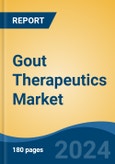Urate-lowering Drugs is the fastest growing segment, North America is the largest market globally
Speak directly to the analyst to clarify any post sales queries you may have.
10% Free customizationThis report comes with 10% free customization, enabling you to add data that meets your specific business needs.
Key Market Drivers
The escalating global prevalence of gout represents a primary catalyst for market expansion in gout therapeutics. This inflammatory condition, driven by various factors including an aging population and lifestyle changes, continues to affect a substantial portion of the worldwide populace. According to a study published in *The Lancet Rheumatology*, in July 2024, 55.8 million people globally had gout in 2020, with projections indicating a significant increase over the coming decades. This rising patient demographic directly translates into an increased demand for effective diagnostic tools and a broad spectrum of treatment modalities, ranging from acute flare management to long-term urate-lowering therapies, placing considerable pressure on healthcare systems to provide comprehensive care.Key Market Challenges
A significant challenging factor impeding the growth of the Global Gout Therapeutics Market is the high cost associated with advanced therapeutic options, coupled with restrictive reimbursement policies. These financial barriers directly limit patient access to innovative and effective treatments, especially in regions with developing economies. When patients cannot afford or access necessary medications due to prohibitive pricing or insufficient insurance coverage, market penetration for these therapies is severely curtailed.Key Market Trends
The Global Gout Therapeutics Market is currently experiencing a significant shift towards more specialized and advanced treatment modalities. This includes a notable trend in the increasing focus on targeted biologic therapies, which offer more precise mechanisms of action compared to conventional treatments. These therapies aim to address specific pathways involved in gout pathogenesis, particularly for patients who do not respond adequately to traditional urate-lowering agents. According to MedCity News, on July 19, 2024, GRO Biosciences raised $60 million in Series B financing to advance its engineered protein technology for gout, aiming to overcome immune response limitations of existing biologic treatments.Key Market Players Profiled:
- Abbott Laboratories Inc
- Medtronic Plc
- Boston Scientific Corp
- Becton, Dickinson and Company
- Novartis AG
- GlaxoSmithKline plc
- Allergen, Inc.
- W. L. Gore & Associates, Inc.
- Stryker Corporation
- Terumo Corporation
Report Scope:
In this report, the Global Gout Therapeutics Market has been segmented into the following categories:By Drug Type:
- NSAIDs
- Colchicine
- Urate-lowering Drugs
- Biologics
By Distribution Channel:
- Hospital Pharmacies
- Retail Pharmacies
- Online Pharmacies
By Region:
- North America
- Europe
- Asia Pacific
- South America
- Middle East & Africa
Competitive Landscape
Company Profiles: Detailed analysis of the major companies present in the Global Gout Therapeutics Market.Available Customizations:
With the given market data, the publisher offers customizations according to a company's specific needs. The following customization options are available for the report:- Detailed analysis and profiling of additional market players (up to five).
This product will be delivered within 1-3 business days.
Table of Contents
Companies Mentioned
- Abbott Laboratories Inc
- Medtronic Plc
- Boston Scientific Corp
- Becton, Dickinson and Company
- Novartis AG
- GlaxoSmithKline plc
- Allergen, Inc.
- W. L. Gore & Associates, Inc.
- Stryker Corporation
- Terumo Corporation
Table Information
| Report Attribute | Details |
|---|---|
| No. of Pages | 180 |
| Published | November 2025 |
| Forecast Period | 2024 - 2030 |
| Estimated Market Value ( USD | $ 2.16 Billion |
| Forecasted Market Value ( USD | $ 3.58 Billion |
| Compound Annual Growth Rate | 8.8% |
| Regions Covered | Global |
| No. of Companies Mentioned | 10 |









